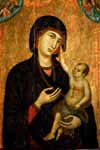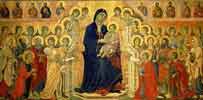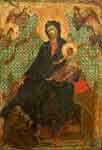 Duccio di Buoninsegna was born in Siena in about 1255.
Duccio di Buoninsegna was born in Siena in about 1255.
He was one of the most important representatives of painting inSiena in the middle of the XIII century.
The Madonna of Crevole (museo dell’opera of the Duomo of Siena) was one of his first works. The style he was taught during his training can be seen here: schematic representation of fabrics and use of gold are typical of gothic miniatures and icons in Byzantine style. While Cimabue and his followers were trying to draw three-dimensional space and volume, Duccio focussed on the elegance of shapes and harmony of colours. This can clearly be seen in the Madonna Rucellai (1285) painted in the church of Santa Maria Novella in Florence and now in the Uffizi Gallery. It was actuallyconsidered one of Cimabue’s paintings but Duccio was later shown to be the author (there are some typically Byzantine elements and lack of volume; volume is an important element in Cimabue’s art).
In 1308 he received a commission for the altarpiece of the Maestà in the  Duomo of Siena (now kept in the Museo dell’opera of the Duomo). The painting, finished in 1311, shows the Madonna on a throne surrounded by angels whereas the back, divided into 26 parts, shows episodes of the passion of Christ. There was a predella in the lower part of the altarpiece to begin with, showing episodes from the childhood of Christ. The very soft outlines and the colours clearly show the influence the French gothic movement had on this artist. The central figure of the Madonna with child has no real volume and is out of proportion compared to the other figures.
Duomo of Siena (now kept in the Museo dell’opera of the Duomo). The painting, finished in 1311, shows the Madonna on a throne surrounded by angels whereas the back, divided into 26 parts, shows episodes of the passion of Christ. There was a predella in the lower part of the altarpiece to begin with, showing episodes from the childhood of Christ. The very soft outlines and the colours clearly show the influence the French gothic movement had on this artist. The central figure of the Madonna with child has no real volume and is out of proportion compared to the other figures.  Another of Duccio di Buoninsegna’s works is Madonna dei Francescani (Siena National Picture Gallery). Critics disagree on when this painting was executed. The altarpiece has a checked background typical of French gothic miniatures.
Another of Duccio di Buoninsegna’s works is Madonna dei Francescani (Siena National Picture Gallery). Critics disagree on when this painting was executed. The altarpiece has a checked background typical of French gothic miniatures.
Works belonging to the last part of the artist’s life, which fully show his painting style (with inspiration from French gothic miniatures, delicate use of colours, rhythmic and linear correspondence, a typically Byzantine iconography) are the Tryptich of the Madonna and the Polyptich of Siena.
Duccio di Buoninsegna died in about 1318.